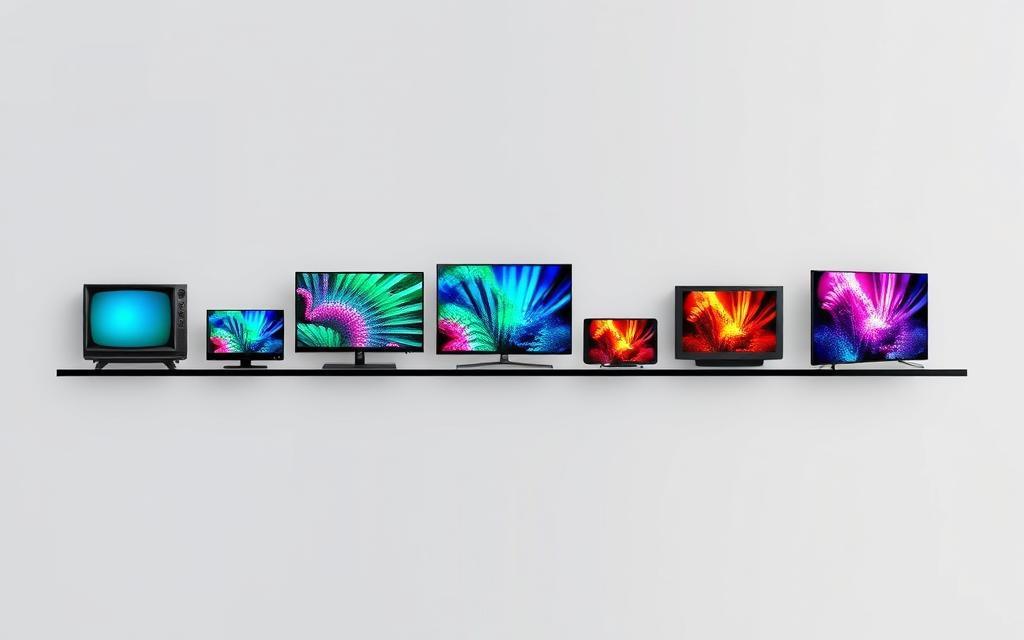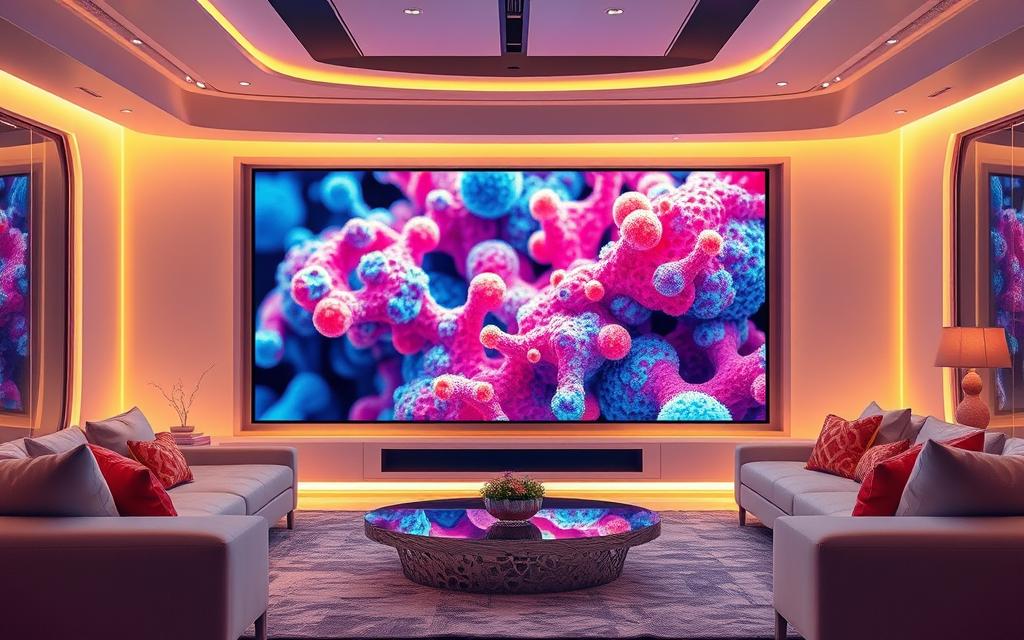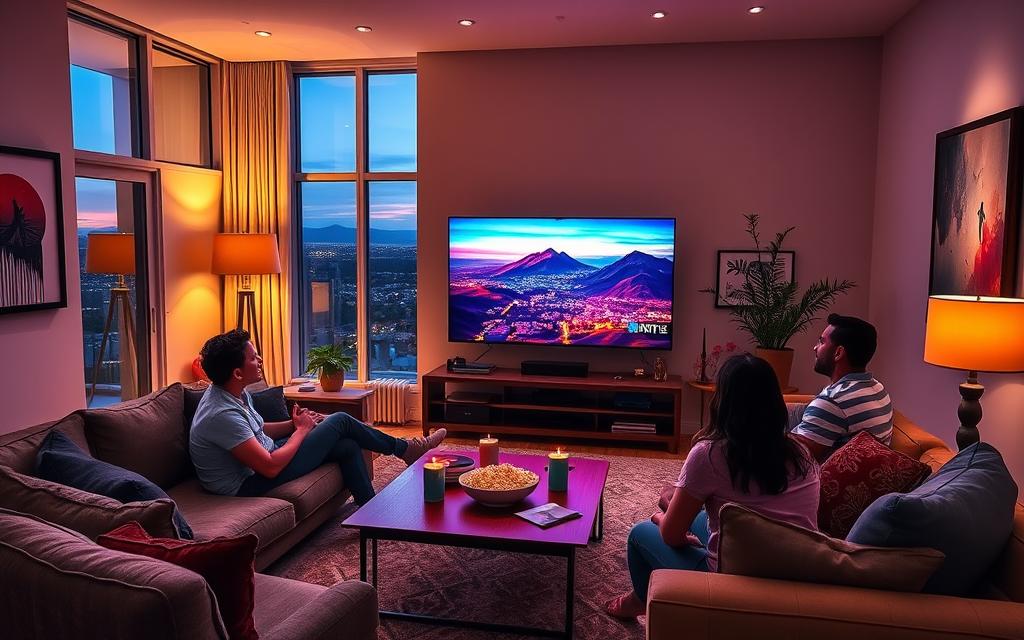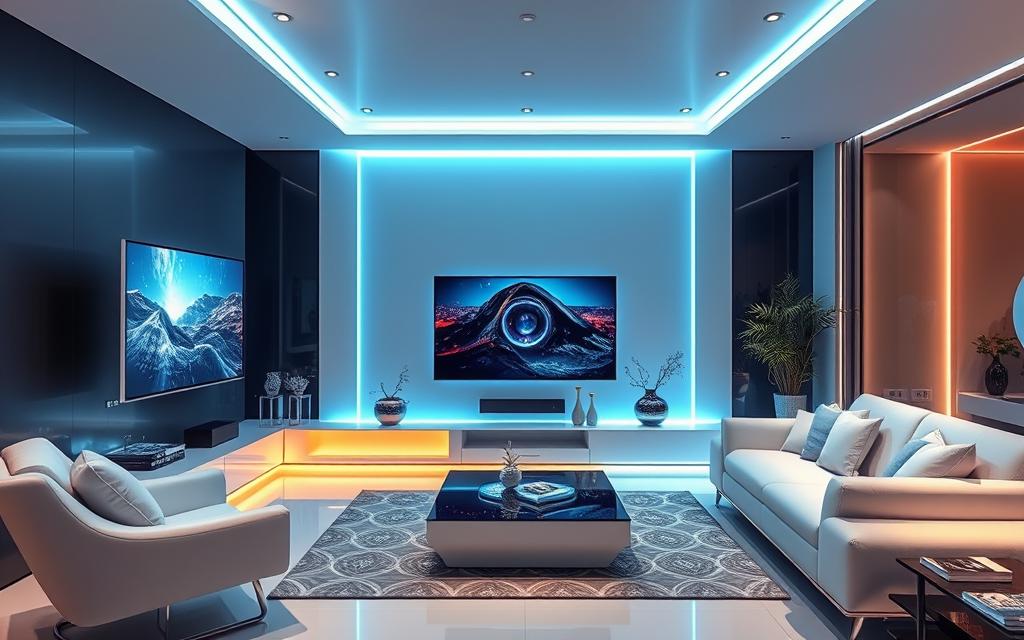What Is Nano TV Technology? Revolutionizing Visual Experiences
Nano TV technology is a new innovation that makes watching TV better. It offers top-notch picture quality and vibrant colours. This technology changes how we enjoy our favourite shows and movies.
NanoCell TVs use special IPS panel technology. This gives wider viewing angles and less flickering. So, you get a better picture overall.
As people want better viewing experiences, nano tv technology is ready to deliver. It promises a more immersive and engaging watch. With its advanced tech and colours, it’s set to change how we see visual content.
Understanding Nano TV Technology: A Comprehensive Overview
Nano TV technology has changed how we watch visual content. It brings a new level of display technology. Nano cells improve the viewing angle and color range, making it more immersive.
LG’s Nano Cell technology uses IPS liquid crystal and nanomaterials about 1nm in size. This boosts color quality significantly.
The core of nano TV technology is its ability to filter out impure colors. This is done with a nanocell layer that contains nanoparticles. These particles absorb unwanted colors, improving picture quality.
This technology offers a detailed look at display technology. It’s perfect for those wanting a better viewing experience.
- Enhanced viewing angle through IPS technology
- Widened color gamut through a new absorbing nanoparticle technology
- Improved color quality, consistent at up to 60 degrees from a normal viewing angle
Nano TV technology combines nano cells and display tech. It shows the latest in visual entertainment. This makes it a thrilling development in display technology.
The Evolution of Television Display Technology
The journey of television display technology has been incredible. We’ve moved from old CRT TVs to modern LCD, OLED, and QLED TVs. Each step forward has made pictures clearer, used less energy, and looked better.
NanoCell TVs have taken it even further. They offer bright colors and deep contrast, making shows and movies look amazing.
Some key changes in TV tech include:
- OLED panels let each pixel shine, making pictures better
- Quantum dot tech boosts colors and contrast
- MicroLED tech makes displays seamless and long-lasting
These updates have made TVs more than just screens. They’ve given us choices in design and features. Now, we can find TVs that are flexible or even see-through.

The future of TV tech is exciting. We’re seeing work on NanoLED TVs, Field Emission Displays, and carbon nanotube screens. These advancements promise even better pictures, less energy use, and new designs.
| Technology | Description |
|---|---|
| OLED | Organic light-emitting diode panels for improved picture quality |
| Quantum Dot | Technology for enhanced color reproduction and contrast |
| MicroLED | Enables seamless displays with improved color accuracy and longevity |
Key Features of Modern Nano TV Systems
Modern nano tv systems have changed how we watch visual content. They offer better colour, brightness, and energy use. These systems use advanced tech like NanoCell to improve colour display.
Some key features of these systems are:
- Enhanced colour reproduction, with a wide range of colours
- Superior brightness and contrast ratios for a better viewing experience
- Energy efficiency improvements for a greener option
LG NanoCell TVs stand out with their wide viewing angles and control over backlighting. They also support HDR Dolby Vision content and Dolby Atmos sound. This makes for an immersive viewing experience.
In summary, modern nano tv systems have many features that make them appealing. They offer advanced tech, better picture quality, and save energy. This makes them a big step up from old TV displays.
The Impact of Nano Technology on Picture Quality
Nano technology has changed how we see pictures. It makes colors, contrast, and brightness better. LG’s NanoCell TVs use nanoparticles to boost picture quality and color.
Nano technology also helps with viewing angles. NanoCell TVs look great from any seat, perfect for big rooms or groups. They work well in bright rooms too, thanks to their high brightness.
Some key benefits of nano technology are:
- Enhanced color accuracy and gamut
- Improved viewing angles
- Higher brightness levels
- Increased contrast and dynamic range
Nano technology has greatly improved picture quality. It offers a more immersive viewing experience. With better color, contrast, and brightness, it’s changing TV displays.

| TV Type | Picture Quality Features |
|---|---|
| NanoCell TV | Enhanced color accuracy, improved viewing angles, higher brightness levels |
| OLED TV | Superior contrast and dynamic range, true black levels |
| QLED TV | Enhanced color output, contrast, and dynamic range with a metallic quantum dot layer |
Benefits of Nano TV Technology for Home Entertainment
Nano TV technology brings many advantages for home entertainment. It offers an immersive viewing experience. With enhanced 4K movies, sports, and gaming, NanoCell TVs give viewers a special experience. For example, LG’s NanoCell TVs have Dolby Vision IQ and Dolby Atmos. These technologies improve picture and sound quality.
Another benefit is reduced eye strain and improved viewer comfort. NanoCell TVs use HDR technology for a better gaming experience. LG’s Filmmaker Mode also ensures a true viewing experience by adjusting picture and processor settings. Key features of NanoCell TVs include:
- Up to one billion possible color combinations, offering a richer color palette than traditional TVs
- Full-array local dimming (FALD), which divides backlight into zones for better brightness control, leading to darker blacks and enhanced dynamic range
- Bluetooth Surround Ready, allowing connections to LG Bluetooth speakers for wireless surround sound

Nano TV technology also offers long-term cost savings. NanoCell TVs are about half the price of OLED TVs. With their unique features, NanoCell TVs are a great choice for home entertainment. They provide an immersive experience, reduce eye strain, and enhance viewer comfort.
Common Misconceptions About Nano TVs
There are many common misconceptions about nano TVs. One big mistake is thinking they’re the same as OLED TVs. Nano TVs have better color and brightness but not the same contrast as OLEDs.
Some people think nano TVs aren’t good for gaming or HDR content. But, many nano TVs are made for these activities. They have low latency and support HDR formats like Dolby Vision. It’s important to compare models to find the right one.
E-ink technology is also being explored, but nano TVs are unique. Knowing what nano TVs offer, like brighter images and vivid colors, helps clear up confusion.
Nano TVs are great for watching movies and TV shows because of their color accuracy. They also use less energy than other TVs, saving on costs. By understanding what nano TVs really offer, you can make a better choice when buying a new TV.
Comparing Nano TV Technology with Other Display Technologies
Nano TV technology is making a big splash in the display world. It offers unique features that stand out from others. When looking at comparison with other display technologies, Nano TV holds its own. It’s often compared to OLED and QLED TVs for picture quality.
Nano TV technology shines in enhancing picture quality and color range. It’s a strong player in the market. The unique NanoCell layer in Nano TV technology filters out unwanted light. This leads to better contrast and realistic colors.
Compared to OLED TVs, Nano TV technology is more affordable. It doesn’t compromise much on picture quality. While OLED TVs have stunning blacks and wide viewing angles, Nano TV technology excels in color accuracy and brightness.
Nano TV vs OLED
Nano TV technology and OLED TVs have their own strengths and weaknesses. OLED TVs are famous for their deep blacks and wide viewing angles. Nano TV technology, on the other hand, is known for its color accuracy and brightness.
Nano TV vs QLED
Nano TV technology and QLED TVs also have unique features. QLED TVs are praised for their color accuracy, thanks to quantum dots. Nano TV technology, however, offers a more budget-friendly option with its own advantages.
Environmental Impact and Sustainability
The world is waking up to the need to cut down on environmental harm. Sustainability in tech, like Nano TV, is key. Nanotechnology in fields like agriculture could help. Now, Nano TV makers are looking at greener ways to produce.
Nano TVs use nanomaterials for top-notch displays that use less energy. To lessen their impact, companies are working on waste reduction and recycling. This saves resources and cuts down on landfill waste.
- Energy consumption: Nano TVs aim to use less power, helping the planet.
- Recycling options: Plans for recycling old TVs are underway, cutting down on waste.
- Manufacturing process: Making Nano TVs is being made more eco-friendly, using fewer harmful materials.
The Nano TV industry is focusing on being greener. This is a big step towards a more eco-friendly future for entertainment tech. As tech keeps improving, we’ll see more ways to be green and responsible.
| Category | Environmental Impact | Sustainability |
|---|---|---|
| Manufacturing Process | Reduced waste and emissions | Eco-friendly practices and materials |
| Energy Consumption | Lower energy usage | Energy-efficient designs |
| End-of-Life Recycling | Reduced electronic waste | Recycling programs and responsible disposal |
Future Developments in Nano TV Technology
As research and development keep moving forward, we’re set to see big changes in nano tv tech. It’s going to make pictures better, use less energy, and be kinder to the planet. Companies like LG and Sharp are leading the way, promising even more advanced and green nano tvs soon.
Some key areas to watch for include:
- Better picture quality, with higher resolutions and more vivid colors
- Less energy use, making nano tvs better for the environment
- More eco-friendly making, using greener materials and processes
Sharp has hit a milestone with a 3,994ppi resolution on a silicon wafer. They aim to hit 6,048ppi for future nanoLED screens. This is a big leap for nano tv tech, and we’re expecting even more amazing breakthroughs soon.
As the tech gets better, we’ll see new features and ideas. Nano tv tech could change how we watch visual content. It’s an exciting time for the industry, and nano tvs will be key in shaping the future of entertainment.
| Company | Resolution | Pixel Density |
|---|---|---|
| Sharp | 3,994ppi | 6,048ppi (planned) |
| LG | 1,920×720 | 167 ppi |
Conclusion: The Future of Visual Entertainment
Nano TV technology is changing the game in visual entertainment. It promises to make our viewing experiences better in many ways. From the colours to the energy use, it’s all set to improve.
Technologies like OLED and QNED are also making big strides. They’re making our screens more immersive and comfortable. And they’re doing it in a way that’s good for the planet too.
Each technology has its own special features. But the main goal is to make pictures better, use less energy, and be kinder to the environment. As we look for the best value, Nano TV and others will lead the way in home entertainment.
The future of watching movies and shows is exciting. It’s filled with new tech that will amaze and entertain us all. It’s a journey we can’t wait to see unfold.
FAQ
What is Nano TV technology?
Nano TV technology is a new way to watch TV. It uses a special layer to make pictures look better and use less energy.
How does Nano TV technology differ from traditional TV displays?
Nano TVs are different because they have a special layer. This layer makes colours look more real, and they are brighter and clearer. They also use less power.
What are the key features of modern Nano TV systems?
Modern Nano TVs have better colours, brightness, and energy use. These features make watching TV more enjoyable and comfortable at home.
How does Nano technology impact picture quality?
Nano technology makes pictures look better. It improves colours, contrast, and brightness. This means Nano TVs offer a more vivid and lifelike viewing experience.
What are the benefits of Nano TV technology for home entertainment?
Nano TVs offer a great viewing experience. They are easy on the eyes and comfortable to watch. They also save money in the long run because they use less energy.
How does Nano TV technology compare to other display technologies?
Nano TVs have their own strengths and weaknesses compared to OLED, QLED, and Mini-LED. Knowing these differences helps people choose the best TV for their needs.
What is the environmental impact and sustainability of Nano TV technology?
Nano TVs are made to be eco-friendly. They consider the environment in their production, energy use, and recycling. This helps reduce waste and protect our planet.
What are the future developments in Nano TV technology?
The future of Nano TVs looks bright. They will likely get even better at showing pictures, using less energy, and being kind to the environment. This will change how we enjoy visual content.









